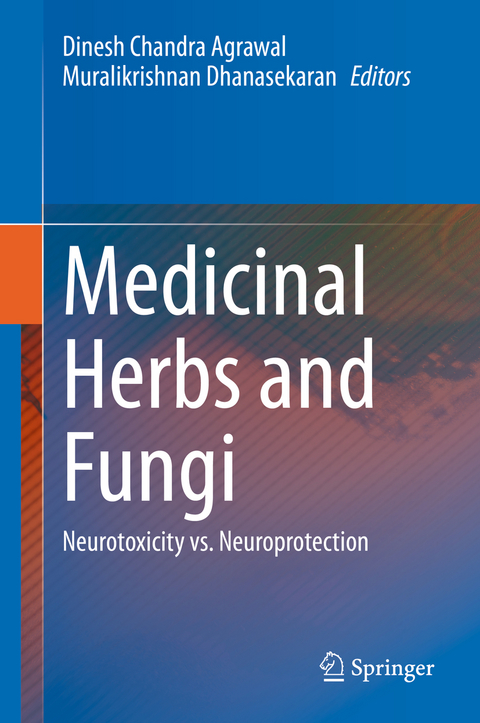
Medicinal Herbs and Fungi
Springer Verlag, Singapore
978-981-334-140-1 (ISBN)
Dr. Dinesh Agrawal, Ph.D., is working as a professor in the Department of Applied Chemistry, Chaoyang University of Technology (CYUT), Taiwan. Before joining the CYUT in 2013, he had served in the CSIR-National Chemical Laboratory, Pune, India, for 31 years. Professor Agrawal has more than 38 years of research experience in biotechnology of diverse species, including medicinal plants and fungi, and has 180+ publications, including five books (3 by Springer). Professor Agrawal has been conferred several prestigious awards and fellowships, including the Alexander von Humboldt Fellowship (Germany), DBT Overseas Associateship (USA), British Council Scholar (UK), European Research Fellow (UK), and INSA Visiting Scientist (India). Professor Agrawal has served as a member of the editorial board of Medicinal and Aromatic Plant Abstracts, NISCAIR, Govt. of India. Presently, he is on the editorial board of the International Journal of Applied Science and Engineering (Scopus) and serving asAssociate Editor-in-Chief of the journal. Dr. Muralikrishnan Dhanasekaran, Ph.D., is a professor in the Department of Drug Discovery and Development at Harrison School of Pharmacy, Auburn University. Before joining Auburn University in 2005, he worked as a post-doctoral fellow at the University of North Dakota, Grand Forks, ND, and Scott & White Clinic / Texas A & M, Temple, TX. His current research involves elucidating the neuroprotective and neurotoxic effects of botanicals and synthetic compounds, discovery, and development of drugs/compounds targeting Alzheimer’s and Parkinson’s diseases. Professor Dhanasekaran completed the New Investigator Research Grant from Alzheimer’s Association, several grants from the Auburn University grants, and several other research projects from a Pharmaceutical Company. He has published more than 200 scientific abstracts, 85 peer-reviewed publications, a book, and several book chapters.
Chapter 1. Mitosis Inhibitors and Medicinal Plants – Neurotoxicity and Neuroprotection.-Chapter 2.The Neurotrophic and Neuroprotective Potential of Macrofungi.- Chapter 3. Andrographolide, a Diterpene from Andrographis paniculata, and Its Influence on the Progression of Neurodegenerative Disorders.- Chapter 4 Ginseng: A Boon or a Curse to Neurodegenerative Diseases.- Chapter 5 Insights into Mechanisms and Models for Studying Neurological Adverse Events Mediated by Pharmacokinetic Interactions Between Clinical Drugs and Illicit Substances of Herbal and Fungal Origin.- Chapter 6 Cannabis Induced Neuroactivity: Research Trends and Commercial Prospects.- Chapter 7 Neurotoxicity of Polyherbal Formulations: Challenges and Potential Solutions.- Chapter 8 Balancing the Neuroprotective Versus Neurotoxic Effects of Cannabis.- Chapter 9 Alpha-Synuclein: Biomarker for Parkinson’s Disease, It’s Estimation Methods and Targeted Medicinal Therapies.- Chapter 10 Screening of Herbal Medicinesfor Neurotoxicity: Principles and Methods.- Chapter 11 Plants with Phytomolecules Recognized by Receptors in The Central Nervous.- Chapter 12 Reserpine Induced Depression and Other Neurotoxicity: A Monoaminergic Hypothesis.- Chapter 13 Traditional Medicinal Plants of Sri Lanka and Their Derivatives of Benefit to the Nervous System.- Chapter 14 Ameliorative Effects of Shodhana (Purification) Procedures on Neurotoxicity Caused by Ayurvedic Drugs of Mineral and Herbal Origin.- Chapter 15 St. John’s Wort: A Therapeutic Herb to be Cautioned for Its Potential Neurotoxic Effects and Major Drug Interactions.- Chapter 16. Neurotoxic Potential of Alkaloids from Thorn Apple (Datura stramonium L.) - A Commonly Used Indian Folk Medicinal Herb.- Chapter 17 Medicinal Plants in Uganda as Potential Therapeutics Against Neurological Disorders.- Chapter 18 Ayurvedic Ideology on Rasapanchak Based Cognitive Drug Intervention.- Chapter 19 Neurotoxic Medicinal Plants of Indian Himalayan Regions: An Overview.- Chapter 20.Neuroprotective Effects of Portulaca oleracea and Portulaca quadrifida Linn.
| Erscheinungsdatum | 29.01.2021 |
|---|---|
| Zusatzinfo | 41 Illustrations, color; 33 Illustrations, black and white; XXII, 510 p. 74 illus., 41 illus. in color. |
| Verlagsort | Singapore |
| Sprache | englisch |
| Maße | 155 x 235 mm |
| Themenwelt | Medizin / Pharmazie ► Medizinische Fachgebiete ► Pharmakologie / Pharmakotherapie |
| Naturwissenschaften ► Biologie ► Botanik | |
| Naturwissenschaften ► Chemie ► Organische Chemie | |
| ISBN-10 | 981-334-140-8 / 9813341408 |
| ISBN-13 | 978-981-334-140-1 / 9789813341401 |
| Zustand | Neuware |
| Informationen gemäß Produktsicherheitsverordnung (GPSR) | |
| Haben Sie eine Frage zum Produkt? |
aus dem Bereich


